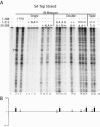Division of labor within human immunodeficiency virus integrase complexes: determinants of catalysis and target DNA capture
- PMID: 16306609
- PMCID: PMC1316026
- DOI: 10.1128/JVI.79.24.15376-15387.2005
Division of labor within human immunodeficiency virus integrase complexes: determinants of catalysis and target DNA capture
Abstract
Following the completion of reverse transcription, the human immunodeficiency virus integrase (IN) enzyme covalently links the viral cDNA to a host cell chromosome. An IN multimer carries out this reaction, but the roles of individual monomers within the complex are mostly unknown. Here we analyzed the distribution of functions for target DNA capture and catalysis within the IN multimer. We used forced complementation between pairs of IN deletion derivatives in vitro as a tool for probing cis-trans relationships and analyzed amino acid substitutions affecting either catalysis or target site selection within these complementing complexes. This allowed the demonstration that the IN variant contributing the active catalytic domain was also responsible for recognition of the integration target DNA. We were further able to establish that a single monomer is responsible for both functions by use of assay mixtures containing three different IN genotypes. These data specify the ligands bound at the catalytically relevant IN monomer and allow more-specific modeling of the mechanism of inhibitors that also bind this surface of IN.
Figures








Similar articles
-
Human immunodeficiency virus type 1 integrase: arrangement of protein domains in active cDNA complexes.EMBO J. 2001 Jul 2;20(13):3565-76. doi: 10.1093/emboj/20.13.3565. EMBO J. 2001. PMID: 11432843 Free PMC article.
-
Photo-cross-linking studies suggest a model for the architecture of an active human immunodeficiency virus type 1 integrase-DNA complex.Biochemistry. 1998 May 12;37(19):6667-78. doi: 10.1021/bi972949c. Biochemistry. 1998. PMID: 9578550
-
Mapping features of HIV-1 integrase near selected sites on viral and target DNA molecules in an active enzyme-DNA complex by photo-cross-linking.Biochemistry. 1997 Sep 2;36(35):10655-65. doi: 10.1021/bi970782h. Biochemistry. 1997. PMID: 9271496
-
HIV-1 integration: an interplay between HIV-1 integrase, cellular and viral proteins.AIDS Rev. 2005 Jan-Mar;7(1):26-43. AIDS Rev. 2005. PMID: 15875659 Review.
-
HIV-1 integrase: structural organization, conformational changes, and catalysis.Adv Virus Res. 1999;52:351-69. doi: 10.1016/s0065-3527(08)60306-1. Adv Virus Res. 1999. PMID: 10384242 Review.
Cited by
-
Natural variation of HIV-1 group M integrase: implications for a new class of antiretroviral inhibitors.Retrovirology. 2008 Aug 7;5:74. doi: 10.1186/1742-4690-5-74. Retrovirology. 2008. PMID: 18687142 Free PMC article.
-
Influence of the amino-terminal sequence on the structure and function of HIV integrase.Retrovirology. 2020 Aug 31;17(1):28. doi: 10.1186/s12977-020-00537-x. Retrovirology. 2020. PMID: 32867805 Free PMC article.
-
In vitro initial attachment of HIV-1 integrase to viral ends: control of the DNA specific interaction by the oligomerization state.Nucleic Acids Res. 2008 Dec;36(22):7043-58. doi: 10.1093/nar/gkn796. Epub 2008 Nov 5. Nucleic Acids Res. 2008. PMID: 18987001 Free PMC article.
-
Insight into the ERVK Integrase - Propensity for DNA Damage.Front Microbiol. 2016 Dec 1;7:1941. doi: 10.3389/fmicb.2016.01941. eCollection 2016. Front Microbiol. 2016. PMID: 27990140 Free PMC article.
-
Role of metal ions in catalysis by HIV integrase analyzed using a quantitative PCR disintegration assay.Nucleic Acids Res. 2006;34(21):6116-25. doi: 10.1093/nar/gkl862. Epub 2006 Nov 3. Nucleic Acids Res. 2006. PMID: 17085478 Free PMC article.
References
-
- Appa, R. S., C. G. Shin, P. Lee, and S. A. Chow. 2001. Role of the nonspecific DNA-binding region and alpha helices within the core domain of retroviral integrases in selecting target DNA sites for integration. J. Biol. Chem. 276:45848-45855. - PubMed
-
- Baker, T. A., M. Mizuuchi, H. Savilahti, and K. Mizuuchi. 1993. Division of labor among monomers within the Mu transposase tetramer. Cell 74:723-733. - PubMed
-
- Bushman, F. D. 2001. Lateral DNA transfer: mechanisms and consequences. Cold Spring Harbor Laboratory Press, Cold Spring Harbor, N.Y.
Publication types
MeSH terms
Substances
Grants and funding
LinkOut - more resources
Full Text Sources

